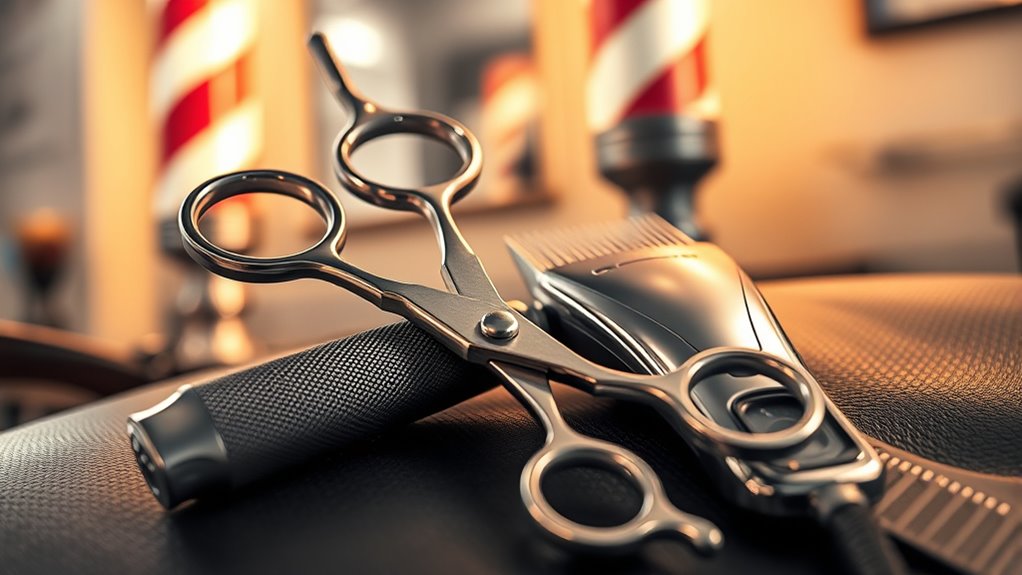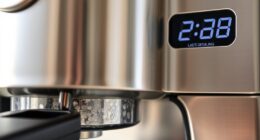Understanding common barber terms like “fade,” “taper,” and “clipper over comb” helps you communicate clearly with your barber and get the hairstyle you want. A “fade” gradually blends hair from short to long, while a “taper” creates a smooth decrease in length for a polished look. “Clipper over comb” is a technique for sharp lines and controlled cuts. Keep exploring to learn more about these essential terms and master your barbering vocabulary.
Key Takeaways
- Key barber terms like “fade,” “taper,” and “clipper over comb” describe specific haircut techniques.
- These terms often have direct translations in different languages, reflecting the craft’s global reach.
- Understanding the terminology helps clients communicate styles accurately across languages.
- Barber tools and styles have unique names that can be translated for clearer international understanding.
- Learning common barber terms in various languages enhances both professional communication and client satisfaction.

Ever wonder what your barber is really saying when they mention terms like “fade,” “clipper over comb,” or “taper”? These words are part of a language developed over centuries, rooted in the history of barbering. Barbers have been shaping men’s styles for hundreds of years, evolving from simple grooming to skilled artisans. In the early days, barbers used basic tools like straight razors and scissors, focusing mainly on shaves and basic cuts. Over time, their craft advanced, and so did their tools. Today, modern barber tools—such as electric clippers, trimmers, and specialized blades—allow barbers to execute precise styles efficiently. This evolution has led to the rich terminology you hear in the barber chair today.
Understanding these terms helps you communicate better with your barber and get exactly what you want. For example, a “fade” refers to a haircut where the hair gradually transitions from shorter at the bottom to longer on top. It’s a technique that has become hugely popular in modern barbering, made possible by advanced clipper technology that can create smooth, seamless blends. “Clipper over comb” is another technique that involves using a comb alongside clippers to achieve a clean, controlled cut. This method is especially useful for creating sharp lines or tapering the sides and back of your head. The word “taper” describes a gradual decrease in hair length, often used to give a polished, professional look, especially around the neckline or sideburns.
Understanding barber terms like fade, clipper over comb, and taper enhances your communication and style.
Modern barber tools have revolutionized how these styles are achieved. High-quality, ergonomic clippers with adjustable blades make it easier to execute complex fades and tapers with precision. Some tools even feature cordless designs, so your barber can work more freely without being tethered to an outlet. The development of these tools stems from a long history of innovation, where barbers have continually refined their craft. Today’s tools combine durability with technological advancements, allowing barbers to deliver consistent, sharp results. For instance, understanding the mechanics of a French press can deepen your appreciation of precise brewing techniques that influence the final look of your hair.
Knowing the history of barbering enriches your appreciation of these terms. It’s a craft that has been shaped by centuries of innovation and artistry. Modern tools are a direct result of this evolution, making it easier than ever to achieve a variety of styles—whether you’re after a classic taper, a modern fade, or a precise clipper-over-comb cut. So next time your barber mentions these terms, you’ll understand that they’re not just jargon—they’re part of a rich tradition of craftsmanship, now enhanced by cutting-edge tools that help them bring your vision to life.
Frequently Asked Questions
How Do Barber Terms Vary Across Different Countries?
You’ll find barber terms vary across countries because of cultural influences on terminology and regional dialect differences. In some places, a “fade” might be called a “taper,” while others use entirely local words. You might notice slang or phrases that reflect local culture, making it important to understand regional nuances. This variation enriches the barbering experience, showing how language adapts to different cultural contexts and regional dialects around the world.
Are There Regional Slang Terms for Common Barber Tools?
Did you know that in some regions, over 60% of barbers use slang for tools? Yes, you’ll hear “buzzers” instead of clippers and “snippers” for scissors in certain areas. Regional slang for clippers can include “clipper beasts,” while scissors might be called “cutters” or “snippers.” These fun terms help barbers connect and add local flavor to their craft, making each haircut unique and memorable.
How Can I Learn Barber Terminology as a Beginner?
To learn barber terminology as a beginner, start with reliable learning resources like online tutorials, barber books, and instructional videos. Practice techniques regularly by working on mannequins or friends to get familiar with terms and tools. Engage with experienced barbers, ask questions, and observe their work closely. Over time, consistent practice and studying will help you confidently understand and use barber terminology in your daily work.
Do Barber Terms Differ for Women’s Hairstyles?
Yes, barber terms can differ for women’s hairstyles due to gender-specific terminology and styling language differences. You might notice terms like “layered cut” or “texturizing” used more often in women’s styling, while men’s cuts focus on terms like “fade” or “clipper cut.” Understanding these gender-specific terms helps you communicate better with stylists and get the look you want, regardless of hairstyle type.
Are There Modern Slang Terms Replacing Traditional Barber Language?
Think of modern slang replacing barber language as the new jazz age, jazzing things up. These days, you’ll hear fresh terms like “fade” or “undercut” instead of traditional lingo. Barber language evolves with pop culture and trends, making conversations more relaxed and fun. So, yes, modern slang is changing how barbers and clients communicate, keeping things current and lively, just like a good tune from the Roaring Twenties.
Conclusion
Now that you’ve learned these barber terms, you’re like a painter with a fresh palette, ready to craft your perfect look. Imagine stepping into the chair, confident and in control, as these words become your brushstrokes. Just as a skilled artist transforms a blank canvas, you can transform your style with a few simple terms. So go ahead—speak with confidence, and let your new vocabulary be the masterpiece that sets you apart.









